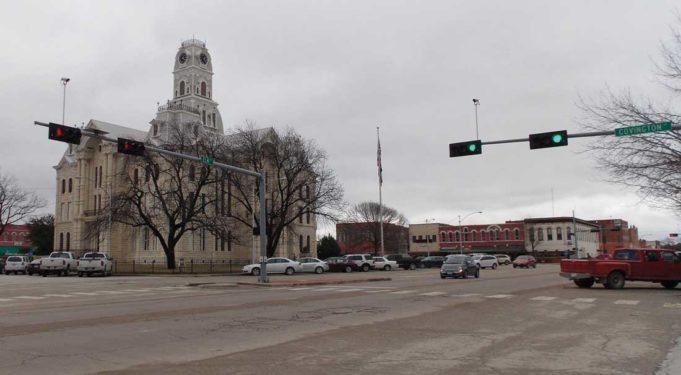When I was younger, I used to hear folks refer to the intellectually disabled as “dull in the head.” Today, I contemplate that as I consider a terrible anniversary, an instance the state of Texas and Hill County pretend has no meaning and no place in contemporary discourse, a day that the city of Hillsboro gets away with every January 20.
One hundred years ago this month, an African-American man named Bragg Williams was burned at the stake in Hillsboro, Texas.
On December 2, 1918, a white woman named Annie Wells and her 5-year-old son Curtis were beaten to death outside their home near Itasca. Their murderer utilized a blunt object to dispatch them and then carried their bodies into the house before setting it aflame to destroy any evidence. Neighbors saw smoke from the fire and retrieved the mother’s and son’s remains before they were too badly burned.
Bragg Williams, described as “tall and ungainly, and seemingly of low mentality,” was discovered less than three miles from the Wells residence and immediately accused of the crime. His accusers subsequently attempted to lynch him, so Williams was transferred to Waco. Later, a group of Texas Rangers transported him to Dallas, where he would remain until his trial date.
On January 16, Williams was escorted back to Hillsboro by the Texas Rangers, and his trial began. Two well-regarded Hill County attorneys — Walter Collins and A.M. Frazier — were appointed to defend Williams and did so under protest. As attorneys for the prosecution and defense seated a jury, Williams sat in the courtroom under the constant guard of six Texas Rangers.
Collins and Frazier entered a “not guilty” plea for Williams by reason of insanity. Williams was obviously mentally handicapped, but the prosecutors — well aware of Williams’ “low mentality” — anticipated the defense team’s plea and brought in Dr. W.L. Allison, a Fort Worth “alienist” (the term for a psychiatrist or psychologist in those days). Dr. Allison undermined the defense team’s plea, insisting Williams was sane or at least not insane.
Williams never testified, but he did return to Hillsboro in the same yellow coveralls he had apparently left in, and the prosecution subsequently produced two white female witnesses who said they saw a black man in yellow coveralls heading in the direction of the Wells residence before the murder, and a young black girl, Smithy McDuffy, who claimed she saw a black man in yellow coveralls running from the direction of the residence after she had heard the screams of Annie Wells. A white jailer named Jess Vanoy and Bragg’s brother Natural were summoned and testified that Bragg had had blood on his shoes the day he was captured.
On Friday, January 17, Williams was convicted of murder, and, quite possibly (if not quite clearly) unaware of what had just transpired or psychologically distraught, he began to laugh. The Texas Rangers promptly departed.
Now, ignoring the fact that A.) it was obviously improbable that a man who was wearing yellow coveralls when he brutally beat a woman and her son to death with a blunt object would not have noticeable blood on what were probably dark shoes and none on his light yellow coveralls and B.) that the murder weapon was never produced and arguably might have been difficult for an intellectually disabled person to successfully conceal or dispose of — the case against Williams was strong — what happened after a guilty verdict was handed down was exceedingly curious.
On the morning of Monday, January 20, the court reconvened for sentencing, and Judge Horton B. Porter condemned Williams to be hanged by the neck until dead on February 21. The guilty verdict was hardly an unpopular result, but once it was handed down and the death sentence imposed, Williams’ attorneys, Collins and Frazier, surprisingly and quite unexpectedly requested a new trial. And when their petition for a retrial was denied, they filed a notice of appeal to the Court of Criminal Appeals.
At approximately 11:45 a.m., a mob — likely upset by the appeal and no longer in the mood for due process — assembled at the Hill County jail and demanded Williams be handed over. When the jailers refused, the mob stormed the facility and seized Williams from his cell. The lynch mob dragged Williams to the courthouse square and tied him to a concrete “safety first” post at the corner of Elm and Covington streets.
Members of the mob quickly collected hay, wood, and coal and piled them around Williams, dousing the combustibles in coal oil. A match was then applied, and the conflagration killed Williams in a matter of minutes. He put up no resistance but was heard to exclaim “Help me, Cap” three times before the flames consumed him.
On January 21, Texas Gov. William P. Hobby denounced the lynching and initiated steps to investigate it. On January 22, Hobby sent a message to the Texas Legislature requesting legislation that would put an end to mob violence and correct the assumption that members of white lynch mobs are not prosecutable. On January 23, Hobby instructed Attorney General Calvin M. Cureton, First Assistant Attorney General W.A. Keeling, and E.A. Berry, assistant attorney general to the Court of Criminal Appeals, to begin investigations of the lynching of Williams.
A Hill County grand jury subsequently examined charges against members of the lynch mob, and Judge Porter did his best to encourage impartiality. He sensed what the prosecution was up against, and his instructions to the grand jury were specific and addressed the necessary integrity the jurors would have to uphold:
“The statute of this State provides your duty, provides the penalty for those who participate in a riot or in a mob or in a lynching. … As your oath has prescribed, it is not a matter of friendship, of love or affection or of feeling. It is a matter prescribed by statute — my cold duty and your cold duty under the law.”
Despite Porter’s charge, the grand jury adjourned without returning bills of indictment.
Cureton, Keeling, and Berry filed a motion to cite 12 members of the lynch mob for contempt of court in regard to the Court of Criminal Appeals because the vigilantes had lynched Williams after his appeal had been filed and was technically pending. In the absence of specific laws against lynching, it was a well-conceived attempt to prosecute members of the lynch mob in a higher court, especially as it was obvious they wouldn’t face prosecution in Hill County.
The motion was described as the first of its kind in Texas, but it, too, fell short.
No action was taken on the motion in February or March, and the effort eventually faded into obscurity.
Reviewing the details of the case today, it’s hard to determine if Bragg Williams was guilty or innocent, but no matter how you look at it, Williams was denied due process. His defense attorneys hadn’t just mailed in his defense. It appears, at least, that they did the hard thing, the unpopular thing, and, theoretically speaking, the appeal might have addressed the prosecution’s “alienist” subversion of their insanity plea.
Guilty or innocent, mentally fit or unfit, what happened to Bragg Williams was a mockery of justice, an affront to human decency, and a vile monstrosity. Whether or not he was “seemingly of low mentality” or dull in the head, the community that roasted him alive was and is dull in the heart. And will remain so until they acknowledge their sins.
E.R. Bills is an Aledo resident and the author of Texas Dissident: Dispatches from a Diminished State 2006-2016 (Eakin Press, 2017).













I grew up in Hillsboro and as a child saw and experienced racism. That town has always been racist and probably still is. My grandmother used to tell me and my brother how white people use to treat black people especially if their skin tone was dark,i remember the burning of a cross on the school campus when the only black school Peabody was to be closed and black children would be going to school with White’s. I never cared for that town and was glad that when I could get the hell out. Yeah old Hillsboro Texas it’s a ghost of a town with many burire secrets.
Yes the black people are just as racists in this town as the white don’t understand why we can’t just all get along God put us all here or as one but as a circle
To single out Hillsboro is ridiculous. This mentality was pervasive everywhere in those times, although the incident that is the subject of the article was atrocious. The irony is that the author of the article lives in Aledo which was easily the most racist team we played in sports in the mid to late 80’s. They called our African American players the “N” word and “cotton pickers” on the football field and defacated in our bus. If you want to label a town, Mr. Bills, you should start by looking in the mirror.
George Wells married Annie Weaver and they had five sons and a daughter. They were Lee, J.W. Jr., J.C., Marshal and Curtis. The daughter was named Jewell and she died at age fifteen. George was a good farmer, and by 1918, he had enough money to purchase a farm. He bought the J.H. Roper Ranch near the Rockwall School. The log part of the first jail in Hill County had been moved there. They added rooms and made a nice home out of it. There was a spring and a pond with large cottonwood trees. People used it to picnic and have get-togethers there. George liked to trade horses and he attended the “Trades Days” in Hillsboro. He had a young Negro named Brad Williams working for him, mostly to tend to the livestock. On Monday, December 2, 1918, Mr. Wells went to “Trades Days” and it was believed that he left Brad to see after things while he was gone. The Wells children went to school at Rockwall, which was only about three hundred yards from the Wells’ home. They came home for lunch on that day, December 2, and J.C. had a headache and left for home about three o’clock. He did not find his mother, and the baby, Marshall, was crying. He picked him up and they went to the garden where he thought his mother might be picking turnips and greens. About this time, school had turned out and as Lee approached the house, he smelled smoke. Frank Turner was the first man to run to the house, where he found Mrs. Wells and Curtis in the old jail part of the house. They were dead and partially burned. The room was so tight that the fire smoldered and went out. A little while before the murder was discovered, Ralph Bailey and his brother W.H. were riding an old jack to-ward the Wells’ home. They were on their way to visit the children of Jim Turner. After they turned off what is now FM 934, they met Brad Williams walking from the direction of the Wells’ home. They noticed that he had blood on his clothes, and of course, when the boys heard about the murder, they told of seeing Brad with the blood on his clothes. Bill Satterfield was the Itasca Constable at that time and he knew just where to find Brad. His family lived just north of Itasca, where the Fred Harlin home was. Brad was there sitting on the woodpile still wearing the bloody clothing. He was arrested and told the whole story in detail. Mr. Wells had a Model T. Ford and he kept it in a car shed near the house. Brad Williams like to crank the car and race the engine. Mr. Wells had reprimanded him several times about it. A few days prior to the murder, Mr. Wells was gone. Brad cranked the car again, Mr. Wells told him to stop, and he refused, so Curtis, age five, pulled the choke and killed the engine. Brad shoved Curtis down and when Mr. Wells came home and heard what happened he fired Brad. A few days later, on the day of the murder, Brad slipped up to the place after the kids went back to school after lunch. He went into the house got the shotgun and hit Mrs. Wells in the head and killed her. Curtis ran for the school. As he ran out of the yard, Brad swung the shotgun at him hitting the gatepost and shattering the stock. He caught Curtis and knocked his brains out with what was left of the gun. He carried Curtis back into the house, placed both bodies in the room, poured coal oil over then and lit a fire. The room was rather tight and the fire smoldered, smoked, and went out about the time people arrived. When Constable Satterfield arrested Brad, he and Earl Pruitt started to the Hillsboro jail with him, but an angry group of men followed them. They finally wound up in Temple where Brad Williams was placed in jail. Brad was tried in Hillsboro in January 1919.
This is my family. Lee was my great grandfather
I am most curious about where you got your information. I’m a descendant of JY McDaniel, the sheriff of Hill County at the time. I’ve been interested in learning more about it for years.
Lee Wells was my grandfather